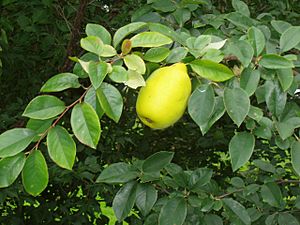Pseudocydonia facts for kids
Quick facts for kids Pseudocydonia |
|
|---|---|
 |
|
| Pseudocydonia sinensis | |
| Scientific classification | |
| Genus: |
Pseudocydonia
|
| Species: |
sinensis
|
| Synonyms | |
|
|
The Chinese quince (scientific name: Pseudocydonia sinensis) is a beautiful tree from the Rosaceae family. This family also includes apples and roses! It grows naturally in southern and eastern China. The Chinese quince is the only type of tree in its group, called Pseudocydonia.
This tree can be deciduous, meaning it loses its leaves in autumn. Sometimes it is semi-evergreen, keeping some leaves all year. Its fruit is quite hard and has a sharp taste. People in East Asia use the fruit in traditional Chinese medicine and as food. These trees usually grow to be about 10 to 18 meters (33 to 59 feet) tall.
The Chinese quince is related to another tree called Chaenomeles. However, the Chinese quince does not have thorns. Its flowers grow one by one, not in bunches. It is also different from the common quince, Cydonia oblonga. The Chinese quince has leaves with jagged edges and no fuzzy coating.
Contents
Names of the Chinese Quince
In China, both the tree and its fruit are called mùguā (木瓜). This name can also refer to papaya or the flowering quince (Chaenomeles speciosa).
In Korea, the tree is known as mogwa-namu (모과나무). The fruit is simply called mogwa (모과). This name comes from the Chinese characters for mùguā.
In Japan, people call both the tree and fruit karin (花梨). Sometimes, in medicine, the fruit is called wa-mokka (和木瓜). This name is similar to the Chinese and Korean names.
What the Chinese Quince Looks Like
Chinese quince trees can grow quite tall, reaching 10 to 18 meters (33 to 59 feet). They have a thick crown with many branches.
Leaves
The leaves grow one after another along the branch. Each leaf is simple in shape. They are usually 6 to 12 centimeters (2.4 to 4.7 inches) long. They are also 3 to 6 centimeters (1.2 to 2.4 inches) wide. The edges of the leaves have small, jagged teeth.
Flowers
The flowers are about 2.5 to 4 centimeters (1 to 1.6 inches) across. They have five petals that are a pale pink color. The trees bloom in the middle of spring.
Fruit
The fruit is a large, oval-shaped pome. It is usually 12 to 17 centimeters (4.7 to 6.7 inches) long. A pome is a type of fruit with a core, like an apple. The fruit has five sections inside. When the fruit ripens in late autumn, it gives off a very strong, sweet smell.
Uses of the Chinese Quince
The fruit of the Chinese quince is hard and has a sharp taste. However, it becomes softer and less sharp after a period of frost.
Food and Drinks
People can use the fruit to make jam, much like regular quince. In Korea, the fruit is used to make mogwa-cheong, which is a preserved quince. They also make mogwa-cha, a type of quince tea.
Traditional Medicine
The fruit is also widely used in traditional Chinese medicine. It is believed to help with certain health problems. For example, it is used to treat conditions like "damp bi syndrome," which is similar to rheumatoid arthritis. Studies have shown that chemicals in the fruit may have properties that help fight antioxidants and antivirals.
Other Uses
The wood from the Chinese quince tree is often used in Japan. It is used to make parts for low-cost shamisen, which are traditional Japanese musical instruments.
Chinese quince is also grown as an ornamental tree. This means people plant it just for its beauty. In Haeju, North Korea, there are two Chinese quince trees planted in 1910. These trees are considered national monuments. They are likely the tallest of their kind in that country.
Gallery
See also
 In Spanish: Membrillo para niños
In Spanish: Membrillo para niños





